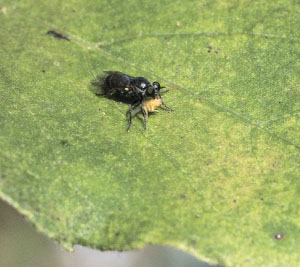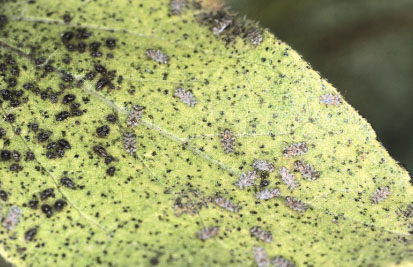
|
AN INSECT GARDEN IN NEW MEXICO - 2
by David B.
Richman, |
The true insects found in my insect garden in Mesilla Park, New Mexico, are quite varied. They, of course, reflect the local fauna of southern New Mexico, augmented with some introduced Eurasian and African species. However, similar types of insects could be found in almost any garden. Some specific types, such as our 'bloom' of green peach aphids or grape leafhoppers, could be found in numerous gardens around the world, but some insects are more local and thus less likely to be seen in other areas. However even these have counterparts on other parts of the planet. A tropical region would possibly exhibit even more variety than we have. I will note that even in tropical settings insects may not be readily evident. Even in Trinidad or Chiapas it is necessary to be carefully observant to discover the biodiversity around the immediate vicinity.

A bumble bee (Bombus sp.) feeds at the flowers of Tithonia in the insect garden.
Butterflies are the usual first interest of most people who bother with insects at all and our list of these scaled winged creatures is fairly impressive. At least two of our four swallowtails have been seen in the garden—the eastern black swallowtail (Papilio polyxenes) and the two-tailed swallowtail (P. multicaudata), both in the Papilionidae. The sulfurs and whites (family Pieridae) are represented by the European cabbage white (Pieris rapae), the checkered white (Pontia protodice), the cloudless sulfur (Phoebis sennae), the orange sulfur (Colias eurytheme), the sleepy orange, (Eurema nicippe) and the dainty sulfur (Nathalis iole). Once we had a visit by a more tropical white angled-sulfur (Anteos clorinde) and a few southern dogface (Zerene cesonia) have occasionally shown up. The gossamer-winged butterflies include Reakirt's blue (Hemiargus isola), western pigmy blue (Brephidium exile) and gray hairstreak (Strymon melinus) Brush-footed butterflies are the painted lady (Vanessa cardui), red admiral (Vanessa atalanta), mourning cloak (Nymphalis antiopa), bordered patch (Chlosyne lacinia), gulf fritillary (Agraulis vanillae), monarch (Danaus plexippus), and queen (Danaus gilippus). Skippers include the checkered (Pyrgus communis) and fiery (Hylephila phyleus) skippers and probably others. At any one time only a few of these would be seen. Occasionally predators take their toll. I disentangled a monarch from the grasp of a large praying mantis (Stagmomantis sp.) on a Tithonia blossom once. Certainly this was the most spectacular incident, but crab spiders and assassin bugs also will take butterflies commonly.

A differential grasshopper suns itself on a leaf in the insect garden.
The non-butterfly insect inhabitants are even more numerous, sometimes devastatingly so. Every year our seedless grape vines on the old chicken run are attacked by the grape leafhopper, while only a few sugar beet leafhoppers can take out the tomatoes by infecting the plants with curlytop virus. In the insect garden the sunflowers are ravaged by lace bugs, which are in turn fed upon by assassin bugs of the genus Zelus. The leaves also provide handy perches for mini robber flies while they are feeding on their prey. Mantids climb the sunflower and Tithonia stems, laying their hard egg cases in various plants branches. Bumble bees and honey bees collect pollen and nectar from sunflowers and Tithonia and apparently drunken honey bees struggle in the opening white blooms of Datura at dusk. Huge differential grasshoppers (Melanoplus differentialis) join meadow long-horned (Tettigoniidae) and slant-faced grasshoppers (Acrididae: Gomphocerinae) during the summer in the tangle, while broad-winged katydids (Microcentrum rhombifolium) make their characteristic ticking noises on the warm summer nights from the nearby mulberry trees.
Quit often I am surprised by visiting insects. Once I walked out back to find a small cloud of dragonflies whirling over the grass. They turned out to be a species in the genus Pantala, which I had not seen before (or since)... I am still not sure exactly what they were doing, but I suspect that they were preying on small insects above the grass. On another occasion cloudless sulfurs poured over by side fence toward the ESE at the rate of one to two a minute. For weeks one summer gulf fritillaries visited the Tithonia and at another time male scoliid (Hymenoptera: Scoliidae) wasps flew over the gardens in a swarm, looking for the emergence of females from the ground where both as larvae fed on the bodies of white grubs (the larvae of June beetles). Occasional spider wasps (family Pompilidae) suddenly appear, often dragging a paralyzed spider behind them. Seemingly from nowhere I often see large desert tenebrionid beetles wandering through the garden.

Large desert tenebrionid (darkling) beetle in the insect garden
The summer is a time of paper wasps (Polestes sp.). These build their open carton nests under the roof edge and occasionally in a shrub or in some low spot where I have to do something about it. I actually do not mind them so much because they keep the tomatoes and other vegetables free of little green caterpillars, but they mine the wooden cloths pins for paper and, what is worse, they will invade the shirts and blue jeans hung up on the line and often be carried inside, where they may sting people in really nasty places. Once a bumble bee (Bombus sp.) colony was formed in a cavity near the garden and if we got near it the bumble bees would buzz loudly and fly up in our faces. Carpenter bees (Xylocopa sp.) are evident often around the blooms in the garden, but they nest singly in hollow plant stems and are not so much of a problem.
Once I saw a colony of army ants (Neivamyrmex fallax) emerge briefly from their underground tunnels in one of the beds. This species is rarely observed on the surface, but I have not seen any other army ants in the garden. New Mexico has 11 species of these “Huns and Tartars” of the insect world, but only this relatively unknown species has shown up here. These tiny ferocious predators attack other ants rather than people.
Leaf-cutting bees make their rounds of the nearby rose bushes, cutting out their characteristic rounded chunks with which to build nests in cracks or hollows in wood. Some other members of the family Megachilidae build pebble lined nests under rocks or flagstones (mason bees) but ours are the types that use circular segments of plant leaves. The same bees clustered around the blooms of a rosemary plant my wife had planted to one side of the insect garden.

A male Stagmomantis on a sunflower leaf in the insect garden
After sunset, sphinx and noctuid moths can be seen feeding at the blossoms of nocturnal flowers. When evening primroses dominated the garden a few years ago some of the white-lined sphinx moths (Hyles lineata - family Sphingidae) laid eggs and we soon had the large black and yellow larvae with a horn on the last abdominal segment.
The garden also supports numbers of aphids in the spring, but these soon are overcome by a host of natural enemies such as the green lacewings (Neuroptera: Chrysopidae) and hover flies (Diptera: Syrphidae). Brilliant green dolichopodid flies are often seen on the sunflower leaves where they overpower tiny prey such as aphids and leafhoppers.
Ground-dwelling insects include the brilliant green and copper nocturnal tiger beetle Megacephala carolina (Carabidae: Cicindelinae), various ground beetles (Carabidae), occasional earwigs (Dermaptera), velvet ant females (Mutillidae) and the ferocious southern fire ant (Soleonopsis xyloni - Formicidae). I have found that the last mentioned insect makes life difficult for anyone accidentally breaking into their nests while working in the garden. Fortunately we do not have the rugose fire ant (Pogonomyrmex rugosus), although colonies can be found within a kilometer or so of the garden. One sting by these large red ants is worth at least ten by the fire ants.
At night during the mid to late summer a recent invader is made known by its attempts to bite ankles and knees—the yellow fever mosquito (Aedes aegypti). Sometimes lacewing (Chrysoperla sp) adults fly around our heads only to be mistaken for a mosquito and often swatted. When bruised the lacewing adults give off a very unpleasant odor. Another insect that shows up around lights at night is the webspinner (Oligotoma nigra - order Embiidina). Only the males fly and I have not yet located the silken tubes of the females. However the males are numerous enough to make me think that the females must be nearby.
.
A small robber fly (Asilidae) and its prey on a sunflower leaf
These are only a few of the six-legged creatures that inhabit the insect garden. A multitude of springtails (not true insects according to recent classifications), beetles (I have not even mentioned ladybird or leaf beetles), ants, flies, moths, bugs, and many others could be found with a little persistence. In the next, and final, installment I will describe the non-insect arthropod inhabitants of the garden. These are in many ways my favorites because I specialized in spiders as a professional biologist.

The assassin bug Zelus and
its prey (an adult lace bug) on
a sunflower leaf

Lace bugs (Corythuca sp, family Tingidae)
feed on a sunflower leaf.
Adults are mottled and nymphs (larvae) are black
Comments to the author, David Richman, are welcomed.
All photos taken by David B. Richman
References used for identification include:
Borror, Donald J., and Richard E. White. 1970. A Field Guide to the Insects. . Houghton Mifflin Co., Boston.
Cranshaw, Whitney. 2004. Garden Insects of North America. Princeton University Press, NJ
Dunkle, Sidney W. 2000. Dragonflies through Binoculars. Oxford University Press.
Opler, Paul A. 1999. A Field Guide to Western Butterflies. Houghton Mifflin Co., Boston.
White, Richard E. 1983. A Field Guide to the Beetles of North America. Houghton Mifflin Co., Boston.
Please report any Web problems or offer general comments to the Micscape Editor.
Micscape is the on-line monthly magazine of the Microscopy UK web site at Microscopy-UK.